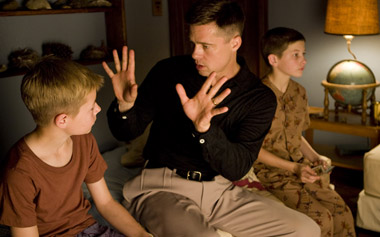In the last three decades, movies have become part of our vocabulary in a way that previously wasn’t possible. Now, more than at any time since the era of Fred and Ginger, we take our cultural cues from blockbusters both good and bad—we adjust our diets based on food-scare documentaries, and flock to YouTube to watch idiots try to recreate scenes from Jackass. A sad little subset of comedies strives to do little more than point out the structural cliches of other movies, as if everything had already been said, their baldness underscored by their titles: Date Movie, Dance Flick, and so on.
There are plenty of factors that play into this: the seemingly endless advertising campaigns, the blurring of the boundary between television and movie stars, the ease of repeating viewings—long gone are the days when you had to go back to the theater to see a movie twice. (These days, you often don’t even need to go the first time, thanks to digital distribution.) In short, movie culture has become, for many, nearly synonymous with culture itself.
It’s odd, then, to reflect on the movie nights of my youth and realize that I recall very little of the supposed cinematic landmarks of the era. Instead, what has stayed with me is the sense of how special—how rare, really—seeing movies was in those pre-VCR days. But one experience was always more special than the rest: the drive-in.
Ours was a two-screen affair; on admission, cars were directed left or right to their respective screens and open fields. It was a setup I haven’t encountered since, but one that paid dividends for a young moviegoer: with a transistor radio, I was able to tune into Poltergeist—showing on the screen behind our car—instead of the mom-approved Annie screening in front.
Today there is still nothing quite like the surreal feel of sitting in your car while watching a movie on a giant outdoor screen, and one can only hope that the tradition will find a way to endure in an era of ever smaller screens. (Wristwatch Theater, anyone?) Luckily, Valley filmgoers are able to experience it right now at the storied Northfield Drive-In.
Straddling the Mass. border with New Hampshire in Hinsdale, the open-air theater is one of only 20 or so theaters in all of New England. Operational since the 1940s—the 80-foot screen used today was rebuilt after the original toppled in a 1951 hurricane—the theater was also used as a location for several scenes in the 1999 hit The Cider House Rules.
Always a populist venue, the Northfield continues to focus on the kind of fare that draws a wide general audience: family-friendly adventures and comedies, children’s’ movies, and big-budget crowd pleasers. The double feature shows start at 8:50 and screen Friday through Sunday; this week brings the animated Pixar feature Cars 2, followed by the superhero saga Green Lantern. (Side note: the Northfield only takes cash.) It may not be a retrospective at Film Forum, but movies under the stars hold a magic all their own.
*
Also this week: Amherst Cinema is screening Tree of Life, the latest from director Terrence Malick. Malick doesn’t make many films, but those he does make—Badlands, Days of Heaven, The Thin Red Line—are consistently hailed as the work of a genius. His new film stars Sean Penn as Jack, a Midwesterner struggling to make sense of the complicated relationship he has had with his father (Brad Pitt in flashbacks). Few directors have Malick’s touch for the telling image, or his ability to make the most simple-sounding story absolutely gripping. An artist in an age when many directors focused purely on producing content, Malick always rewards close viewing.
Jack Brown can be reached at cinemadope@gmail.com.



